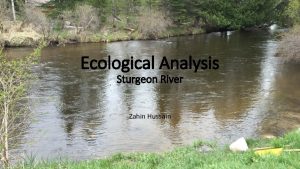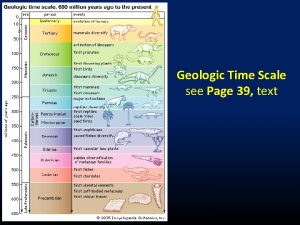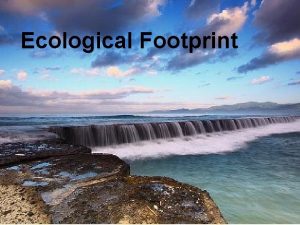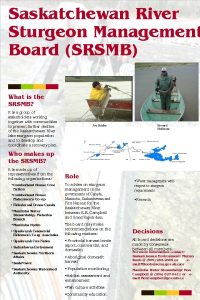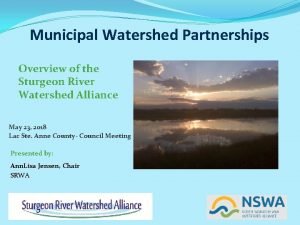Ecological Analysis Sturgeon River Zahin Hussain Map of













- Slides: 13

Ecological Analysis Sturgeon River Zahin Hussain

Map of Area

Biotic Factors • The observation of certain types of organisms can be correlated with the quality of the stream. Organisms can be divided into three groups: Sensitive, Somewhat-Sensitive, and Tolerant. Sensitive organisms are only able to live within a small parameter. If many sensitive organisms are found, the stream quality will be rated higher. Somewhat Sensitive organisms live within a larger parameter than sensitive insects, and a large diversity of these organisms can also mean a stream of high quality. Tolerant organisms live within a wide expanse of stream conditions. These organisms will almost always be found in the stream unless the stream is of ill quality.

Biotic Factors • Plant Organisms • Grasses • Vertebrate or Invertebrates • Sensitive • Caddisfly Larvae • Mayfly Nymphs • Stonefly Nymphs • Water Snipe Flies • Somewhat Sensitive • Beetle Adults • Net-Spinning Caddisfly Larvae • Tolerant • Aquatic Worms • Midge Larvae • Other • Sea Lamprey (While we did not find Sea Lampreys, there was evidence that Sea Lampreys were living in the stream). Stream Quality Excellent >48 Good 34 -48 Fair 19 -33 Poor <19 A scale for stream quality is provided at the left. Sensitives species are worth approximately 5 points, somewhat-sensitive species are worth approximately 3 points, and tolerant species are worth approximately 1 point. With a score of 33. 7, the stream quality is rated at a level of Good.

This datasheet uses the species found within the stream in order to quantitatively describe the stream quality. The stream quality was found to be 33. 7 or Good.

Stream Quality Observations The stream quality was found to be good. Many sensitive organisms were found. Therefore, the stream would be of higher quality. For example, stoneflies and caddisflies were found. Stoneflies can only live in streams with a high dissolved oxygen content, and Caddisflies can only live in higher quality streams.

Abiotic Factors The river was moving quite fast at its center, which made it difficult to observe organisms in the center and on one of the outer banks. The bottom of the river was made up of soft areas of silt and areas that were full of rocks. The stream was at a temperature of 9°C, which was cold, but not as cold as the air at 7°C. The river was cloudy. It was also noted that there were nets in the center of the stream for the purpose of catching sea lampreys. Some pieces of logs were found in the river. On the bank of the river, there was a variety of large rocks that were embedded into the soil. The previous days rain created a wet environment. Many of the abiotic factors can be accounted for by the previous day’s storm. The wind may have broken many tree branches into the stream. Furthermore, upstream the water would have built up in order to create the high velocity of water that was in the center of the stream. These findings seem to be typical of the ecosystem, as according to the Water Shed Council’s 2012 Volunteer Stream Monitoring Report, the river has a high velocity. Furthermore, many of the abiotic factors are merely a result of the temperature and overall weather.

Suggestions for Site The Biological Diversity of the site should be directly correlated with an increase in the number of sensitive species. Therefore, the PH, Dissolved Oxygen content and levels of erosion should be kept within a threshold for the comfort of the more sensitive individuals. The more tolerant individuals should also be kept in check, especially those that reproduce quickly. These species would quickly be able to outcompete the more sensitive individuals.

Suggestions for the site (Contd). The water quality is good. In order to maintain the quality of the stream, fertilizer use could be limited within the recommended range. Furthermore, boat use could be limited, as the emissions could change the PH of the water in order to make sensitive species less viable. In order to prevent erosion from occurring, eroding-resistant dirt and silt could be packed onto the banks.

Indications of Human Activity There was an obvious indication of human activity, or more so, research activity. There was a prominent net set up for the purpose of researching the lamprey population within the river. There was also a road near to the observation site. In order to make such human activity less stressful, the number of cars near the stream could be limited. Furthermore, research could be done less frequently or in a less physical manner.

The Monitoring Datasheet to the left shows the water test that was first taken. This test includes water temperature, water turbidity, and observations on the weather. The Datasheet also includes the specific location of where the test occurred.

This is me looking for organisms within a log that was found at the bottom of the river.

Sources University of California Museum of Paleontology http: //www. ucmp. berkeley. edu/arthropoda/uniramia/ephemeroptera. html Watershed Council http: //www. watershedcouncil. org/ U. S Department of the Interior Geological Survey http: //waterdata. usgs. gov/nwis/rt? Google Maps http: //www. maps. google. com
